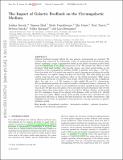| dc.contributor.author | Suresh, Joshua | |
| dc.contributor.author | Bird, Simeon | |
| dc.contributor.author | Vogelsberger, Mark | |
| dc.contributor.author | Genel, Shy | |
| dc.contributor.author | Sijacki, Debora | |
| dc.contributor.author | Springel, Volker | |
| dc.contributor.author | Hernquist, Lars | |
| dc.contributor.author | Torrey, Paul A. | |
| dc.date.accessioned | 2015-09-11T12:54:31Z | |
| dc.date.available | 2015-09-11T12:54:31Z | |
| dc.date.issued | 2015-02 | |
| dc.date.submitted | 2014-12 | |
| dc.identifier.issn | 0035-8711 | |
| dc.identifier.issn | 1365-2966 | |
| dc.identifier.uri | http://hdl.handle.net/1721.1/98457 | |
| dc.description.abstract | Galactic feedback strongly affects the way galactic environments are enriched. We examine this connection by performing a suite of cosmological hydrodynamic simulations, exploring a range of parameters based on the galaxy formation model developed in Vogelsberger et al. We examine the effects of AGN feedback, wind mass loading, wind specific energy, and wind metal-loading on the properties of the circumgalactic medium (CGM) of galaxies with M[subscript halo] > 10[superscript 11] M[subscript ⊙]. Note that while the V13 model was tuned to match observations including the stellar mass function, no explicit tuning was done for the CGM. The wind energy per unit outflow mass has the most significant effect on the CGM enrichment. High-energy winds launch metals far beyond the virial radius. AGN feedback also has a significant effect, but only at z < 3. We compare to high-redshift Hi and Civ observations. All our simulations produce the observed number of Damped Lyman α Absorbers. At lower column density, several of our simulations produce enough Lyman Limit Systems (LLS) 100 kpc from the galaxy, but in all cases the LLS abundance falls off with distance faster than observations, with too few LLS at 200 kpc. Further, in all models the Civ abundance drops off too sharply with distance, with too little Civ 100–200 kpc from the galaxy. Higher energy wind models produce more extended Civ but also produce less stars, in tension with star formation rate density observations. This highlights the fact that circumgalactic observations are a strong constraint on galactic feedback models. | en_US |
| dc.language.iso | en_US | |
| dc.publisher | Oxford University Press | en_US |
| dc.relation.isversionof | http://dx.doi.org/10.1093/mnras/stu2762 | en_US |
| dc.rights | Creative Commons Attribution-Noncommercial-Share Alike | en_US |
| dc.rights.uri | http://creativecommons.org/licenses/by-nc-sa/4.0/ | en_US |
| dc.source | arXiv | en_US |
| dc.title | The impact of galactic feedback on the circumgalactic medium | en_US |
| dc.type | Article | en_US |
| dc.identifier.citation | Suresh, J., S. Bird, M. Vogelsberger, S. Genel, P. Torrey, D. Sijacki, V. Springel, and L. Hernquist. “The Impact of Galactic Feedback on the Circumgalactic Medium.” Monthly Notices of the Royal Astronomical Society 448, no. 1 (February 10, 2015): 895–909. | en_US |
| dc.contributor.department | Massachusetts Institute of Technology. Department of Physics | en_US |
| dc.contributor.department | MIT Kavli Institute for Astrophysics and Space Research | en_US |
| dc.contributor.mitauthor | Vogelsberger, Mark | en_US |
| dc.contributor.mitauthor | Torrey, Paul | en_US |
| dc.relation.journal | Monthly Notices of the Royal Astronomical Society | en_US |
| dc.eprint.version | Author's final manuscript | en_US |
| dc.type.uri | http://purl.org/eprint/type/JournalArticle | en_US |
| eprint.status | http://purl.org/eprint/status/PeerReviewed | en_US |
| dspace.orderedauthors | Suresh, J.; Bird, S.; Vogelsberger, M.; Genel, S.; Torrey, P.; Sijacki, D.; Springel, V.; Hernquist, L. | en_US |
| dc.identifier.orcid | https://orcid.org/0000-0001-8593-7692 | |
| dc.identifier.orcid | https://orcid.org/0000-0002-5653-0786 | |
| mit.license | OPEN_ACCESS_POLICY | en_US |
| mit.metadata.status | Complete | |
